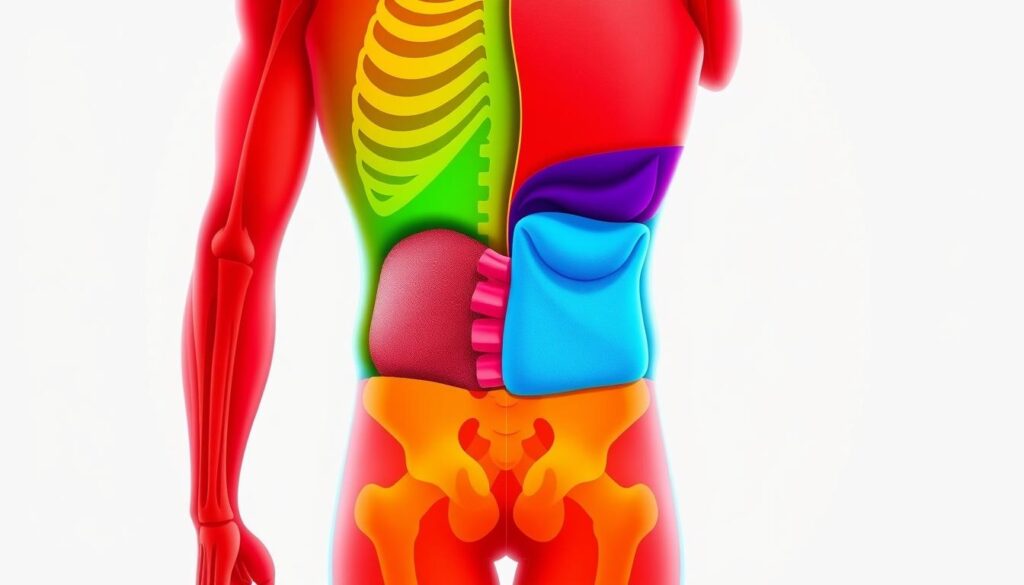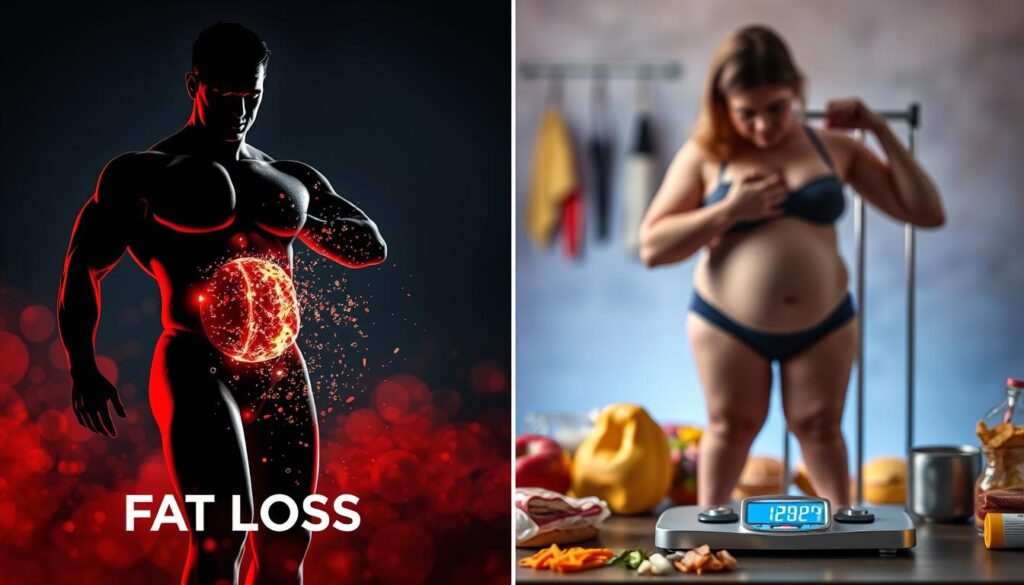Improving your health and looks is important. Knowing the difference between fat loss and weight loss matters. Weight loss means losing weight, which can be from muscle, water, or fat. Fat loss is about losing extra body fat, which is key for health and fitness.
We will look at the main differences between fat loss and weight loss. We’ll see why focusing on fat loss is better. And we’ll talk about how to make lasting changes in your body. By the end, you’ll know how to reach your health and fitness goals better.
Key Takeaways
- Weight loss means losing weight, including muscle, water, and fat. Fat loss is about losing extra body fat.
- Focusing on fat loss is better for your body, health, and keeping weight off long-term.
- Knowing the difference helps you set better goals for your health and fitness journey.
- Using a balanced approach with good food, strength training, and cardio helps make lasting changes.
- Measuring progress with body fat percentage and physical measurements gives a full picture of your changes.
Understanding Body Composition Basics
Understanding your body composition is key to managing weight. It’s not just about the number on the scale. Your body composition includes fat, muscle, water, and bone. Knowing this helps you see your health and fitness better.
The Four Main Components of Body Weight
- Water – Water makes up 50-60% of your body weight. It’s vital for many body functions.
- Fat – Fat, both essential and storage, is a big part of your weight.
- Muscle – Muscle is important for your metabolism and how well you move.
- Bone – Your bones and connective tissues also add to your weight.
Why Body Composition Matters More Than Weight
The scale number is just the start. Your body composition shows your health and fitness better. Someone with more muscle and less fat might weigh more but be healthier.
Role of Water Weight in Body Composition
Water weight changes can affect your weight. But, they don’t always show changes in body composition. Knowing about water weight helps you track progress and make better weight management choices.
| Component | Percentage of Total Body Weight |
|---|---|
| Water | 50-60% |
| Fat | 20-30% |
| Muscle | 10-20% |
| Bone | 5-10% |
“Maintaining a healthy body composition is not just about the number on the scale, but about the balance of your muscle, fat, and water levels. This is the key to achieving sustainable weight management and optimizing your overall health and fitness.”
Fat Loss vs Weight Loss: Key Differences Explained
When you want to get fit, you might hear “fat loss” and “weight loss” a lot. But they mean different things. Knowing the difference helps you set the right goals and see how you’re doing.
Weight loss means you weigh less, but it can be from fat, muscle, or water. Fat loss is about losing extra fat. It’s better for your health and looks.
- Women’s essential fat range is naturally greater than men’s due to deposits in breasts, uterus, and sex-specific sites.
- Healthy/normal body fat percentage in women: 20% to 30%. In men: 10% to 20%.
Measuring your body fat and taking body measurements is better than just looking at the scale. The scale can change for many reasons, but fat loss shows real changes in your body.
| Metric | Focus | Benefits |
|---|---|---|
| Weight Loss | Decrease in overall body weight | Includes reductions in fat, muscle, and water |
| Fat Loss | Reduction of excess body fat | Improves health and appearance, preserves muscle mass |
Going for fat loss is more important than just losing weight. Losing fat and keeping muscle makes your body healthier and more balanced. It helps you stay fit for a long time.
Why Focusing on Fat Loss Is More Important
Targeting fat loss is key for healthy weight management. It’s more important than just looking at the scale. Losing fat and keeping muscle mass boosts your health and metabolism.
Health Benefits of Targeted Fat Loss
Lowering body fat reduces disease risks like heart disease and diabetes. It also helps avoid muscle loss with age. This keeps you moving better and safer as you get older.
Impact on Metabolic Health
Keeping muscle while losing fat helps control blood sugar and cholesterol. Muscle burns more calories than fat. This boosts your metabolism and helps keep a healthy weight.
Long-term Sustainability Benefits
Focus on fat loss and muscle keeps you on track for good. It stops the weight from coming back quickly. This makes your weight loss journey more stable.
“The percentage of individuals who lose weight and successfully maintain the loss has been estimated to be as small as 1 to 3 percent.”
By focusing on fat loss, you improve your health and metabolism. This sets you up for long-term success in managing your healthy weight.
Understanding Your Body’s Weight Fluctuations
Going on a weight loss journey can be bumpy. Your weight can change every day. This is normal and can be due to many things like how much water you drink, your glycogen stores, and how much sodium you eat. Knowing about these changes helps you not get too upset when you don’t see results right away.
Your water weight can change fast. This can make your weight look like it’s changing a lot, even if you’re not really losing or gaining fat. Things like hormonal changes, stress, and some medicines can make your water weight go up and down. It’s better to look at how you’re doing over time, not just day by day.
- More than 400 genes are linked to obesity and weight gain. Your body might have a weight it wants to stay at.
- Hormones and how your body burns calories can change. This can make it hard to lose weight the same way again.
- Trying to prevent weight gain might work better for people who tend to gain weight easily.
Your body is complex, and weight changes are part of that. By understanding this, you can keep your eyes on your body composition goals. Don’t let daily weight changes get you down.
“Successful weight loss may result in a body that looks different than expected, commonly with stretch marks and loose skin. Emotional health is independent of weight, and some individuals may experience dissatisfaction even after significant weight loss.”
Keep a steady calorie deficit and exercise regularly. Listen to your body and adjust as needed. With time and effort, you can see lasting metabolism-boosting results.

Measuring Progress: Beyond the Scale
The numbers on the scale don’t show everything. Your body fat percentage tells more about your health. You can use body fat scales, skinfold calipers, or DEXA scans to measure it.
Progress photos and body measurements show changes in your body. Tracking your waist-to-hip ratio helps see how your body changes. A smaller waist means less body fat.
Body Fat Percentage Measurement Methods
Body fat scales use bioelectrical impedance analysis. They send a small electrical current through your body. But, they might not always be very accurate.
For a better measure, get a professional to use skinfold calipers or DEXA scans. They can give you a more accurate body fat percentage.
Using Progress Photos and Measurements
Take regular progress photos and body measurements. They show changes in your body, even if the scale doesn’t change fast.
Advanced Tracking Technologies
Use advanced tracking technologies like bioimpedance analysis scales or DEXA scans. They give detailed insights into your body composition. You can learn about your fat, muscle, and bone density.
Don’t just look at the scale. Use different methods to measure your progress. This way, you can understand how your body changes. It helps you make better choices about nutrient dense foods and exercise.
Building and Preserving Muscle Mass
Keeping your muscle mass when losing fat is very important. It helps keep your metabolism healthy and makes your body look good. By focusing on keeping your muscles, you’ll stay healthy for a long time.
Eating enough protein is key to keeping your muscles. You should eat 0.8 to 1.1 grams of protein for every pound of your body weight. Try to eat 25 to 30 grams of protein at each meal to help your muscles grow.
Doing resistance training regularly is also very important. The CDC says you should do strength training at least 2 times a week. You can do exercises like pushups, squats, and lunges without needing gym equipment.
Don’t cut too many calories. A small calorie deficit is good for losing fat, but too much can hurt your muscles. Try to cut no more than 500 calories a day to keep your muscles safe.
By following these tips, you can keep your metabolic rate high. This supports your health and helps you look good. Finding the right balance between losing fat and keeping muscle is the secret to lasting success.

“Maintaining muscle mass is crucial during fat loss efforts. Strategies include consuming adequate protein, engaging in regular resistance training, and avoiding excessive calorie deficits.”
Nutrition Strategies for Effective Fat Loss
To lose fat well, you need a smart plan for food. Aim for a small calorie cut, eat enough protein, and choose foods full of nutrients. This way, you can lose fat and keep your muscles strong.
Protein Requirements for Fat Loss
Protein helps keep your muscles when you eat fewer calories. Try to eat 0.8-1.1 grams of protein for every pound of your body. Eat foods high in protein like lean meats, eggs, fish, and legumes.
Optimal Macronutrient Balance
For losing fat, it’s more about eating fewer calories than the exact mix of carbs, protein, and fat. Just make sure you get a little bit of everything to stay healthy and full of energy.
Meal Timing and Frequency
Plan when and how often you eat to control hunger and lose fat better. Try intermittent fasting to see what works for you. But, don’t follow very strict diets that are hard to keep up.
“The key to effective and sustainable fat loss is to create a moderate calorie deficit, focus on nutrient-dense foods, and find a balanced approach that you can maintain long-term.”
Exercise Protocols for Maximum Fat Loss
To lose fat and keep your muscles, mix cardio and strength training. The Physical Activity Guidelines say to do 150-300 minutes of cardio weekly. Also, do muscle-strengthening activities two times a week.
High-intensity interval training (HIIT) is great for losing fat. It makes your metabolism go up and burns more calories after working out. Make sure your workouts fit your likes and fitness level for lasting results.
It’s important to balance cardio and strength training. Try different activities like walking, lifting weights, playing tennis, doing yoga, and jogging. This keeps your workouts fun and your body challenged. By focusing on keeping muscle and boosting metabolism, you’ll reach your fat loss goals and live a healthy lifestyle.


A Life-Changing Experience with This Weight Loss Supplement (Nagano Tonic)
I’ve always struggled with finding a weight loss solution that actually works for me. Like many, I’ve tried numerous diets, exercise routines, and supplements over the years—some worked for a short time, but nothing ever gave me long-term results. That was until I decided to try the weight loss supplement I found : Link to the Supplement.
From the moment I started using it, I noticed a difference. Not only did I feel more energized, but my cravings also became more manageable. The best part? I started seeing results much quicker than I anticipated! Over the course of just a few weeks, I noticed a significant reduction in belly fat and overall weight loss that I hadn’t been able to achieve before.
What makes this supplement stand out from all the others I’ve tried is how it supports me in my daily routine without any jitters or energy crashes. I’m able to stay focused and motivated, which has made it easier to stay on track with my diet and exercise plan.
This product truly exceeded my expectations, and I feel more confident and healthier than ever before. If you’re struggling with your weight loss journey like I was, I highly recommend giving this supplement a try. It’s been a game-changer for me, and I’m sure it can work wonders for you too!
Contant Them on email .. tonicnagano50@gmail.com
I’ve tried so many weight loss products over the years, but nothing worked like this supplement! Since I started using it, I’ve noticed a big difference in my energy levels and appetite control. In just a few weeks, I’ve lost weight and feel so much better. It’s been easy to stick with, and the results speak for themselves. Highly recommend this to anyone looking to make a real change!
wasn’t sure what to expect, but this weight loss supplement has really impressed me! After just a few weeks of use, I’ve already dropped a few pounds and feel more motivated to stay active. It’s helped curb my cravings and boosted my energy throughout the day. I’m excited to keep going and see even better results. Definitely worth trying!
Reach them on tonicnagano50@gmail.com